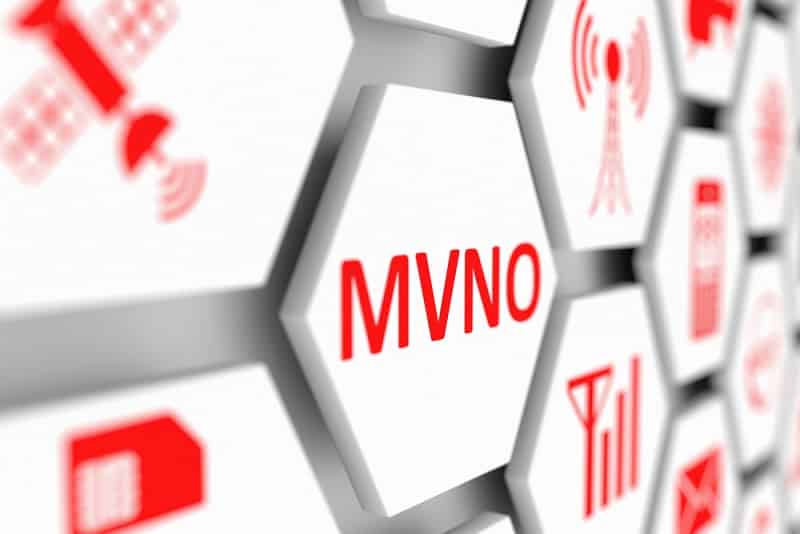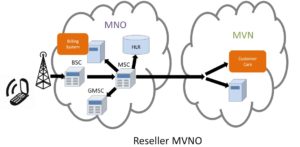
Mobile virtual network operator (MVNO) sounds like something extremely complicated, but it’s actually pretty straightforward. An MVNO is simply a carrier that operates on a virtual network, meaning that they rent their data and coverage from one of the Big Four carriers—AT&T, Verizon, Sprint, and T-Mobile—aka. mobile network operators (MNOs). But if MVNOs are using the Big Four networks, then why would anyone bother going with one rather than the real deal?
MVNOs Ain’t What They Used to Be
MVNOs aren’t new by any stretch. In 2005-2006, they exploded onto the market with the likes of Disney Mobile and Amp’d Mobile, but it didn’t take long for that explosion to fizzle out. The thing is MVNOs had the short end of the stick. They were using the MNO’s networks, just the same as they are today, but they weren’t getting any support from the MNOs beyond the rental use of those networks.
Fast forward to today and the MVNO is a very different, and more successful, entity. This success is due in large part to the lower price point and increased flexibility their service provides for customers. But the bottom line is that MVNOs are succeeding because the big carriers are letting them succeed. How does it work between the MNOs and the MVNOs? Essentially, the big cellular carriers lease coverage and data bandwidth at a wholesale price and the MVNO then resells this to the customer at a low cost.
In addition to the leasing of the network coverage, the big carriers are flexible in their pricing, they offer backend and call center support in many instances, and in many cases they help at the device end of the service, as well. Back in the 2000s, when MVNOs were trying to make a go of it, they had to handle all of their customer care and logistics, billing, sales, marketing, and device procurement themselves. Now that they have this help from the Big Four, MVNOs have a much better chance of success.
How MVNOs Work
The big carriers are generally open to partnering with MVNOs and providing them with the support they need. But big carriers want to be sure that the MVNO has a business plan, adequate funding, and the technical requirements that meet their needs, such as IMSI codes, SIM cards, and interconnection rights. Sometimes the support received from the MNOs is basic, including customer care and a billing system, but more often than not these days, MVNOs receive full infrastructure support.
What’s in it for the MNOs? You would think they don’t want the extra competition. Yet, they do! It turns out that the MVNOs can tap into markets that the big carriers just can’t access, such as youth and international communities. However, there are those who believe that the real reason MNOs are supporting the MVNOs is because they have an “if you can’t beat ‘em, join ‘em” attitude. Since the MVNOs are around and successfully taking a part of the market share, it is in the best interest of the big carriers to get a piece of the pie.
Out of the Big Four carriers, Sprint appears to be the go-to for MVNOs. The relationship between Sprint and the MVNOs goes way back, but more recently, Sprint’s incredible wholesale rates and the flexibility of their policies have made it even easier for MVNOs to offer incredible deals and plans to their customers, such as the ability to be credited for unused minutes or pay for additional usage without penalty. That’s a pretty sweet deal!
The Good, The Bad, and The Ugly
The lowdown on the good side on MVNOs is that customers can save a ton of money. There are a few reasons for this, including the following:
- It is easy to get very good monthly plans through an MVNO. Try $40 per month for a smartphone plan, for which the Big Four will charge $100. These are immediate savings customers can put directly into their pockets.
- There are no contracts to sign. This means you are free to use the service as much or as little as you want and you can walk away at any time with no penalty.
- There is a lot more flexibility when it comes to MVNO cell phone plans. Pre-paid plans are an option, meaning you pay when you can afford it and there is no credit check required. The other type of plan is an unlimited plan that averages data speeds of 2-3 GB. However, there are some important things for users to watch for. One is to read the fine print and make sure you are aware of the minimum monthly payment required on the account. You should also pay attention to the rates for each service category, such as talk, text, and data, and ensure the plan you choose doesn’t have an expiration date for the minutes.
- With the Big Four contract plans, where if you go over the limit you will get charged exorbitant monthly fees, crazy overage rates, and if there are minutes you don’t use, you lose them. However, with an MVNO that offers prepaid plans, the unused minutes will roll over to the next month, which means you never lose out. Plus, if you hit your limit, then you can just pay for more.
- No credit or social security checks are required, which means anyone can get cell phone service with just their name and their money. This also means that if there is a security concern with the cell phone carrier, you don’t have to worry. They don’t have your personal information so it can’t be compromised.
- Your old phone number can be ported, just like with the bigger carriers. Of course, this is because law requires all providers to offer the portability of local numbers, but it’s still nice to know you can get this.
- In many cases, you are able to use your own unlocked phone with your MVNO service, although some phones won’t work. Just be sure to check with your MVNO provider to find out what your options are. You should also know that it doesn’t matter whether you use an Android or iPhone on your prepaid plan.
However, there are some drawbacks to having a plan with an MVNO, which many people are willing to put up with for the lower prices and lack of contract associated with using one of these service providers. These drawbacks include the following:
- During times of high usage on the mobile network, priority is often given to the Big Four carrier customers, leaving MVNO customers with degradation of call quality and outages that can be frustrating.
- It is common for MVNO customers to have their data speed capped. For instance, the MVNO customer could have a cap of 8 MBps, where as a MNO customer could be allowed up to 20 MBps. For this reason, be sure to check for any data speed caps when you sign up for your plan.
- There is no roaming for MVNO customers. For most people, this is fine, but for anyone who travels a lot, roaming becomes a necessity.
- It is common for MVNO users to have fewer options when it comes to device availability. The big carriers that support the MVNOs frequently put a restriction on certain devices they carry, not allowing the MVNOs to promote or use those devices for their own service.
In light of the above, these few disadvantages are acceptable for many people who are in favor of the flexibility and lower cost of the MVNO plans. After all, not everyone needs what the big carriers have to offer and not everyone wants to pay the price to get it.
The Future of the MVNO
When you look at the history of the MVNO, with its tumultuous start a decade ago, its unceremonious stalling out, and its more recent revival, it begs the question of where MVNOs are headed in the future. Certainly, MVNOs have been a stimulant in the cell phone marketplace, providing a certain level of competition in certain customer niches. But will this be enough to keep them afloat?
Not long ago, MVNOs were able to make consumers unique and innovative offers that were new and appealing to many who didn’t like or couldn’t take advantage of the standard offers made by the big carriers. However, these offers are now a dime a dozen. Add to this the thin profit margins these MVNOs are experiencing in an oversaturated market and it becomes obvious they are on shaky ground. In fact, GSMA Intelligence reports that half of the existing MVNOs will face significant challenges to stay afloat.
So what will it take for these carriers to survive into the future? It will require them to be able to do the following:
- Keep up with innovation in the mobile phone industry
- Be highly adaptable as trends in the industry change
- Continue to take advantage of niche markets that will continue to pop up
When it comes to keeping up with innovation and trends, MVNOs also have to compete with over-the-top (OTT) service providers, who are now emerging with their new mobile app services that can be accessed from the consumer’s device. It seems that mobile app services are quickly becoming an integral part of the future of the mobile phone and MVNOs would be wise to jump on the bandwagon, developing their own mobile apps to compete with the OTT service providers. These mobile apps will take the cell phone experience to the next level for consumers, allowing them to integrate their cell phone service with the social media and sharing phenomenon that is now firmly entrenched in today’s mobile experience.
Ultimately, MVNOs are at the beck and call of the Big Four carriers, but for the present time, they seem to have a relationship that is beneficial for both sides and for the consumer. Many consumers who would not have service through the MNOs, are happy to give their business to the MVNOs. Provided MVNOs continue to tap into niche markets and provide their customers with innovative new products and services, they stand a good chance at surviving into the foreseeable future.
